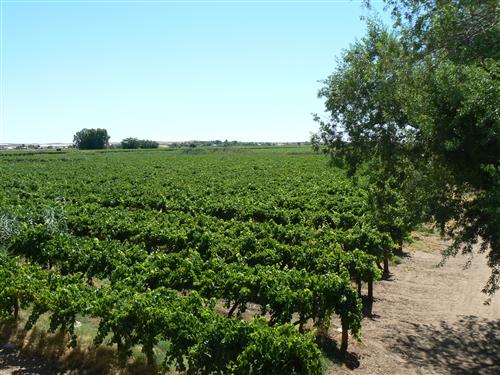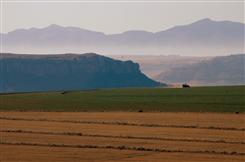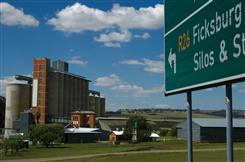The agricultural water demand is presented for the following three Water Management Areas (WMAs) in the Orange-Senqu River basin.
Upper Orange Water Management Area (WMA)
Much of the Upper Orange Water Management Area is devoted to agricultural activity: commercial farming including extensive irrigation, rain-fed agriculture, and livestock farming. Large areas under irrigation for the growing of grain and fodder crops have been developed along the main rivers, mostly downstream of irrigation dams, with irrigation water representing approximately 80% of the water requirements in the Water Management Area (DWAF 2003a; DWAF 2004a). From limited records, it is estimated that approximately 8% of irrigation water is abstracted from boreholes, 35% is delivered through canal systems and the remaining 57% abstracted directly from the rivers.
Vaal Water Management Areas
Current Department of Water Affairs (DWA) records suggest that there are 12 200 ha under irrigation in the Upper Vaal Water Management Area—requiring 9% of the entire Water Management Area water supply (DWAF 2003c).
The Middle Vaal Water Management Area has an estimated 22 256.3ha(2006) of land under irrigation, and water requirements for irrigation account for about 40% of the requirements in the Water Management Area (130,6 Mm³). Agricultural products include maize, groundnuts, sorghum, and sunflower. Livestock operations include beef, dairy and sheep farming.
In the Lower Vaal irrigation accounts for 80% of the water use. The largest irrigation scheme is the Vaalharts Scheme (34 000 ha) situated between the Vaal and Harts Rivers. The total area under irrigation in the Lower Vaal Water Management Area is estimated at just over 25 000 ha (DWAF 2003e). Agriculture is predominantly cultivation of grains and fodder crops, and livestock farming.
Lower Orange Water Management Area
Agriculture is a major economic activity along the lower reaches of the Orange River. Livestock farming is generally practiced in the drier areas, with high-value crops such as grapes, pistachios, citrus, pecans and vegetables grown in a narrow riparian strip along the Orange River, supported by intensive irrigation supplied directly from the river. From the Orange/Vaal confluence to the river mouth at Oranjemund, the commercial agricultural sector is economically important, accounting for 94% of the current total water requirement of 1,130 Mm3/a (DWAF 2003b; DWAF 2004b). This irrigation is supplied with releases from the Vanderkloof and Gariep Dams. Commercially, the value created per unit of water used is much higher here than in other parts of the basin

Vineyards, such as these in the Lower Orange River region of South Africa, require signficant volumes of water to be productive.
Source:Kruchem 2008
( click to enlarge )
Water Challenges for South Africa’s commercial Agriculture
As water becomes scarcer in the Orange-Senqu River basin, the area of land under irrigation here is still growing. At the moment it amounts to roughly 300 000 hectares of crops, among them low value crops grown west of the Vanderkloof dam, where the average annual rainfall is less than 300 millimetres. Apart from that, many farmers still operate sprinkler systems in arid regions where there is low air humidity, high temperatures and relatively high wind speeds. Under these circumstances, much of the water evaporates before it can reach the ground. Despite of that even the idea to irrigate at night, when it is cooler, is not very popular with a lot of farmers.
There are other ways in which South African farmers can reduce water wastage, experts point out: They can modify their methods of applying the water; and they can switch to high value products such as olives, nuts, citrus fruits or grapes. Proof that many farmers have started doing this can be found in the foreign trade statistics. They indicate that South Africa – once self-sufficient in both maize and wheat – now imports three million tonnes of grain per year. At the same time the country exports agricultural products worth nearly 25 billion Rand. These include increasing quantities of fruit, vegetables and wine, and diminishing amounts of grain.
Water-starved South Africa is a net exporter of “virtual water”. In other words, the goods exported require more water to produce than the goods imported. To produce just one kilogramme of zucchini, for example, farmers outside Ladybrand must draw 1 000 litres of water from the Caledon, 15 000 litres of water are consumed to produce a single kilogram of steak.
How can South Africa motivate its farmers to use water more efficiently? – It is time to enforce existing laws and manage consumption more effectively, leading experts say. South Africa’s Water Act of 1998 has been praised internationally as ground breaking legislation that highlights this key issue: Farmers are no longer permitted to use all the water found on their land. Today they need a license which details where, when and for what purpose they can extract water from a river, canal or aquifer, and what quantity. The licence is subject to periodic renewal and the allocation can be reduced, if insufficient water is available to meet needs. Farmers and other water users must also present water management plans that show how they will use this precious natural resource efficiently.
The problem is compliance: In practice farmers often ignore the relevant legislation because enforcement is poor. Experts suggest that enforcement agents from the Department of Water Affairs routinely check watercourses for illegal pumping stations. And if they use satellite technology, they can monitor whether or not a particular maize field is irrigated only during the maize season, as the farmer’s licence stipulates. If crops are being watered outside that season, then the farmer is acting against the law. And by checking his electricity consumption, the DWA can more or less see how much water has been pumped.
Apart from that it is considered necessary to encourage effective irrigation methods and discourage the cultivation of low value, water-thirsty crops in extremely dry regions. For this purpose experts suggest the consequent use of pricing mechanisms to moderate demand. For decades the South African authorities have been building new dams and canals, and they have maintained infrastructure to serve farmers in the Orange-Senqu River basin. Now, for a start, the DWA is charging for all economic use of water provided by newly built infrastructure.
Critics point to a strong agricultural lobby, which has prevented this pricing scheme being applied to previously built infrastructure by stoking fears of job losses. At the same time, the critics say, the government wants to ensure that South Africa produces as much of its own food as possible. This is a controversial position, given that the Southern African Development Community (SADC) is striving for greater regional economic integration. The critics point out that in the Orange River basin, irrigated agriculture can be questioned both ecologically and economically. Other SADC countries such as Angola, Zambia and Mozambique have soils that are more fertile and receive more rain, meaning that crops can be produced much more cheaply. Using these capacities, a lot of money could be saved and a lot of South Africa’s scarce water resources conserved.
 Agriculture on the Highveld in South Africa. Source:Vogel 2009 ( click to enlarge ) |
 Grain Silos on the Highveld. Source:Vogel 2009 ( click to enlarge ) |
